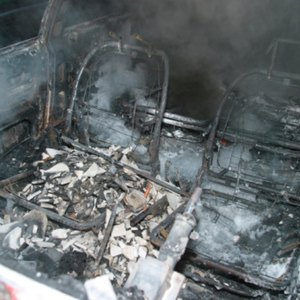
Automobile damage by fire can be covered under your collision insurance, your uninsured or underinsured motorist property damage coverage or the other driver’s liability coverage if the fire is a result of an accident; otherwise it may be a comprehensive claim. Some states have a fire and theft coverage as well as a physical damage policy that covers your vehicle if you elect to pay for the additional coverage. In all situations except the other driver’s liability, you must have coverage in addition to liability on your vehicle to pay the claim.
Blue Book Value
Your insurance policy defines the terms for your coverage, and it probably covers “repairs” for damage. If your car is a total loss, or if the insurer decides it is not economical to make repairs, you receive actual cash value. Insurance adjusters base loss calculations for a total loss by fire on blue book value, determined from Kelley Blue Book at kbb.com or at Edmunds.com.
Policy Limits
Adjusters submit the actual cash value of the loss, but your insurance policy covers only to policy limits. The insurance policy for the other driver is equally restricted to policy limits. Most states have a property damage liability limit that is the third number on the liability coverage. A policy written for 30/60/25 has $30,000 for an individual, $60,000 for an accident and $25,000 in property damage. If the other driver has insurance, he probably has sufficient property damage coverage for your vehicle. If you are hit by an uninsured motorist, your uninsured motorist property damage may pay your claim.
Payment
Your insurer pays only actual cash value. Any amount paid includes reductions for depreciation including mileage, year model and accessories. The insurer subtracts the deductible if the claim is for collision or comprehensive. A claim under your underinsured motorist property damage does not include a deductible. If the insurer determines the cause of the fire was from a collision that was the other driver’s fault, you pay no deductible because payment comes from the liability insurance of the other driver. States often regulate the terms included in automobile insurance policies written in the state.
Salvage Value
The insurance company makes no attempt to cover your replacement cost of a vehicle. You only receive the actual cash value of the vehicle, and the insurer takes the car. It receives salvage value to offset the payment of the claim so the actual amount the insurer pays out is significantly less than it appears to be. Insurers and adjusters look for fraud in automobile fire claims. Arson and vandalism are comprehensive insurance coverages, but if the insured caused the damage, the insurer does not cover the loss.
References
- Auto Insurance: Types of Auto Insurance Coverage
- Auto Insurance Claim Advice: Auto Fire Claim -- Insurance Companies Will Be Checking for Fraud
- Progressive. "Types of Car Insurance Coverage." Accessed Sept. 14, 2020.
- Arkansas Attorney General's Office. "Consumer Alert: Fender Bender Facts." Accessed Sept. 14, 2020.
- National Association of Insurance Commissioners. "A Consumer's Guide to Auto Insurance," Page 8. Accessed Sept. 14, 2020.
- Allstate. "Property Damage Liability Coverage—What Is It?" Accessed Sept. 14, 2020.
- Michigan Department of Insurance and Financial Services. "Brief Explanation of Michigan No-Fault Insurance," Page 1. Accessed Sept. 14, 2020.
- Progressive. "How Do Car Insurance Deductibles Work?" Accessed Sept. 14, 2020.
- American Family Insurance. "Do I Pay My Auto Deductible When I’m Not At Fault?" Accessed Sept. 14, 2020.
- Allstate. "Someone Hit My Parked Car. What Do I Do?" Accessed Sept. 14, 2020.
- Esurance. "How Car Accidents Can Affect Your Rate." Accessed Sept. 14, 2020.
- California Department of Insurance. "So You've Had an Accident, What's Next?—What Happens After I File the Claim With My Insurance Company?" Accessed Sept. 14, 2020.
- Insurance Research Council. "One in Eight Drivers Uninsured." Accessed Sept. 14, 2020.
- Infinity Insurance. "Uninsured Motorist Coverage: What Is UM Insurance?" Accessed Sept. 14, 2020.
- California Department of Insurance. "Automobile Insurance Information Guide." Accessed Sept. 14, 2020.
Writer Bio
Linda Richard has been a legal writer and antiques appraiser for more than 25 years, and has been writing online for more than 12 years. Richard holds a bachelor's degree in English and business administration. She has operated a small business for more than 20 years. She and her husband enjoy remodeling old houses and are currently working on a 1970s home.

